Leave No Trace | How To Plan a Minimal Impact Elopement
Leave No Trace Center for Outdoor Ethics is a non-profit organization whose mission is educating people on how to protect the natural spaces we all enjoy. They have established a set of principles to follow when spending time outdoors, and Magnolia + Ember, a certified LNT photography team, is committed to integrating these guidelines into every adventure elopement, ensuring we experience and preserve the beauty of nature responsibly.





If you’re planning an outdoor elopement, it’s likely because you’re captivated by the beauty of nature. To keep these beautiful places accessible for future generations, it’s essential to enjoy them in a sustainable and respectful way. Weddings, elopements, and photo sessions can have a significant impact on the environment. Without following Leave No Trace principles, here’s what could happen:
- Locations that are currently open for weddings and elopements may be closed off to special events and professional photography, making it impossible to return for future vow renewals or anniversary sessions.
- The spot where you exchanged your vows could suffer so much damage or litter that it’s closed for restoration, meaning it won’t look the same when you return in the future.
- The cost and availability of special event permits could increase, making it harder to host events on public lands.
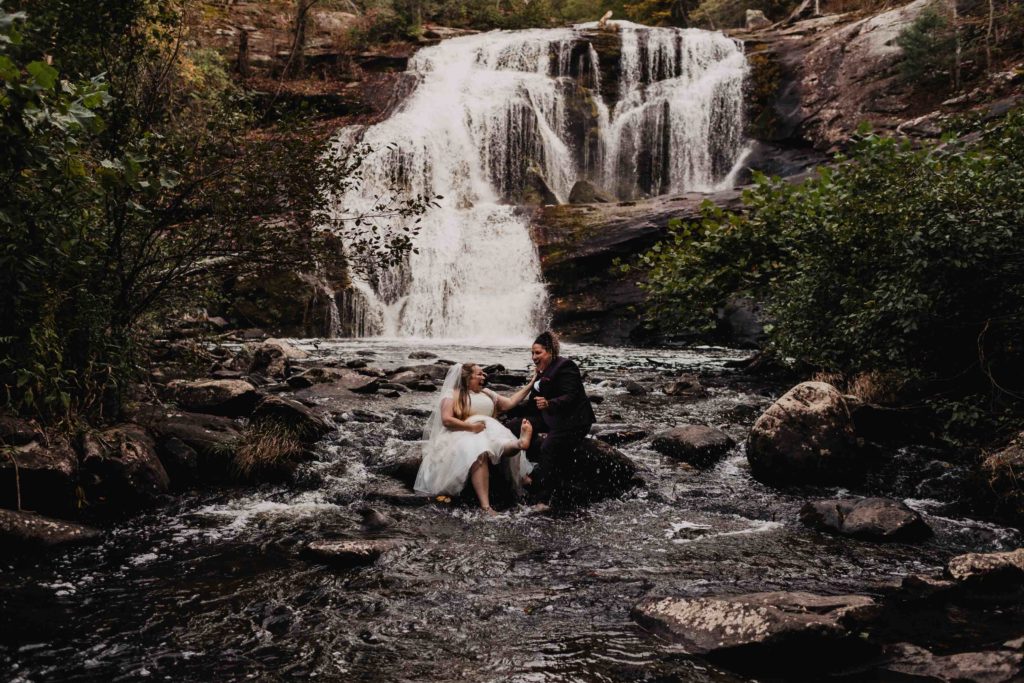
Whether you’re drawn to the outdoors for its peace, beauty, or awe-inspiring views, we all share the responsibility of protecting these places. By reducing our impact while we visit, photograph, and celebrate outdoors, we can ensure these beautiful spots are preserved for a long time to come. You don’t need to limit your celebration to minimize your impact—this guide will support you every step of the way as you plan, prepare, and get married in a breathtaking, natural setting!



What are the LNT principles?
In simple terms, Leave No Trace is a set of ethics and practices designed to help us enjoy and protect the outdoors simultaneously. LNT follows seven key principles that guide our decisions to minimize impact while we’re outside:
- Plan Ahead & Prepare
- Travel & Camp on Durable Surfaces
- Dispose of Waste Properly
- Leave What You Find
- Minimize Campfire Basics
- Respect Wildlife
- Be Considerate of Other Visitors
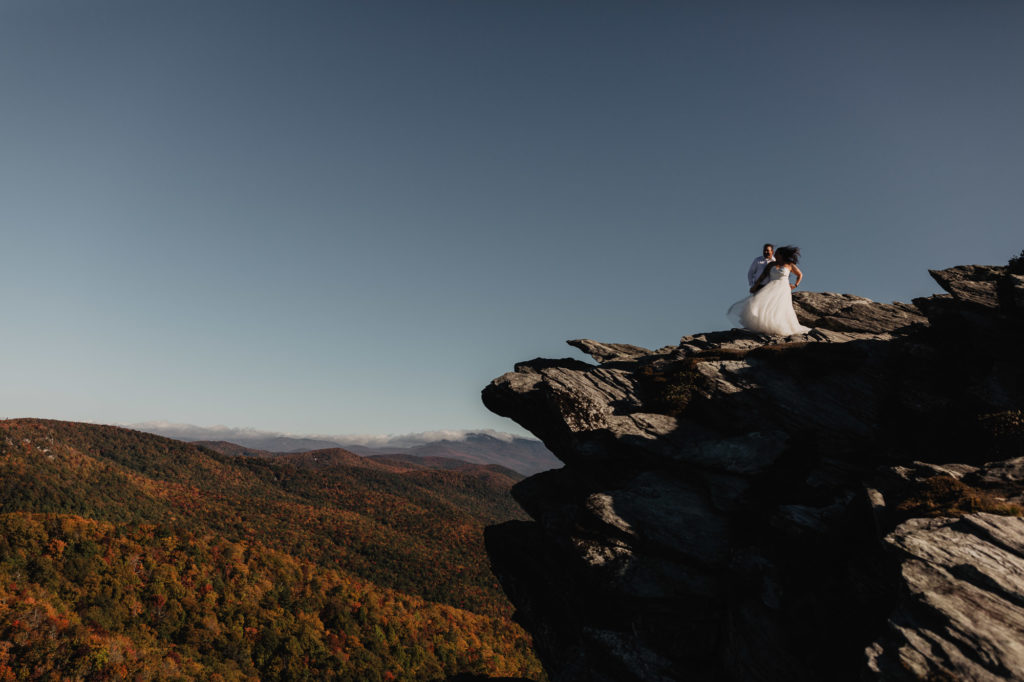
Guidelines To Help Protect Our Public Lands
Plan to Stick to Trails & Durable Surfaces
Always stick to established trails, avoid trampling vegetation, and never step on wildflowers. If there’s no trail or if we’re hopping on rocks for photos, we must be extra mindful of the terrain to prevent damage. Many of these natural areas are incredibly fragile, and flowers can take decades to recover once they’ve been damaged!
What are Durable Surfaces & When is it okay to go off-trail?
OK to go off-trail
Rock, sand and gravel: These surfaces are highly durable and can tolerate repeated trampling and scuffing. (Just be aware that lichens that grow on rocks are vulnerable to repeated scuffing).
Ice and snow: The effect of travel across these surfaces is temporary, making them good choices for travel assuming good safety precautions are followed and the snow layer is of sufficient depth to prevent vegetation damage.
Sometimes OK to go off-trail
Vegetation: The resistance of vegetation to trampling varies. Careful decisions must be made when traveling across vegetation. Dry grasses tend to be resistant to trampling, while wet meadows, moss, tundra plants, and other fragile vegetation quickly show the effects of trampling. If vegetation shows signs of trampling, it creates what are called “social trails,” (or “satellite trails”) which encourage other visitors to go off-trail because there is the appearance of a space used for travel. As a general rule, travelers who must venture off-trail should spread out to avoid creating paths that encourage others to follow.
Not OK to go off-trail
Living soil: Sometimes referred to as cryptobiotic crust, or crypto, living soil is often found in desert environments, and is extremely vulnerable to foot traffic. One footstep can destroy this fragile soil, causing damage that will take many years to overcome if ever.
Desert puddles and mud holes: Water is a scarce resource for all living things in the desert. Do not walk through desert puddles, mud holes or disturb surface water in any way. Potholes are also home to tiny desert animals.
Fragile Vegetation: Moss, alpine meadows, tundra plants, wildflowers, and other fragile plants are not resistant to trampling and can take years to grow back if stepped on.


Leave Everything You Find
While it might seem tempting to take a souvenir token from the environment to remember your day, it’s best to leave everything as it is. If you spot something you want to remember, capture it in a photo instead of taking it with you. Your wedding dress will naturally pick up a bit of the landscape for you to take home, and that’s enough. Wildflowers, rocks, bark, and driftwood must stay where they are so future visitors can enjoy them too.
Pack Everything Out
Flower petals, toilet paper, food scraps, champagne cork wrappers—everything. Even items that seem “natural” or “biodegradable” are likely not native to the area and can take a long time to decompose. In the meantime, they have the same impact as leaving trash behind.
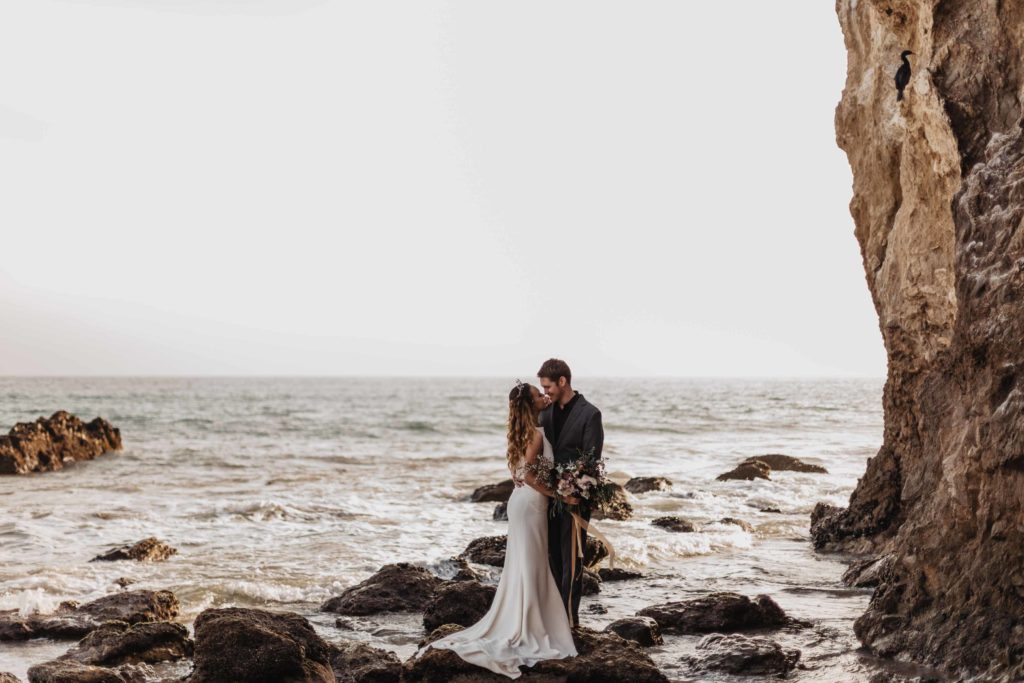
Bouquets & Flowers
If you’re hiking with a bouquet on your backpack, make sure it’s sturdy and won’t drop petals along the way. Depending on the environment, you may also want to check local rules and regulations to see if non-native flowers are allowed. It’s always best to avoid bringing invasive plant species to prevent pollen or seeds from spreading. Additionally, be mindful of the impact floral installations can have, such as leaving holes in the ground. Always be sure to fully disassemble and pack out any floral arrangements you bring.
Popping Champagne
Be sure to find the champagne cork after you pop it, and remember to pack out the wire cage and wrapper. Also, keep in mind that alcohol is prohibited in some National Parks, and the sugar in champagne can harm delicate ecosystems. If you’re looking for a fun “spray photo” with a bubbly effect, sparkling water makes a great alternative—it looks just like champagne in photos, and you can save the actual champagne for later enjoyment!

Confetti, Seeds, and Rice
Most National Parks prohibit throwing anything on the ground, and even biodegradable confetti is not a good option. Instead, consider sustainable alternatives like collecting local native leaves, or using ribbon sticks, glow sticks, or snowballs for a fun and eco-friendly celebration.
Human Waste
Sometimes, going #2 on the trail means you’ll need to hike back out with a bag of you-know-what. WAG bags are a great option in areas where facilities are unavailable. In certain environments, like deserts and high-alpine regions, it’s required to pack out all waste. In other areas, you can dig a cat hole at least 6 inches deep. Be sure to make plans for yourself, your guests, and your pets, and always be prepared to pack it out.
Be Careful With Fire
Always check for fire bans in your area before having a campfire or using candles, fireworks, smoke bombs, or sparklers. A quick online search will tell you if there are any restrictions. Only use designated fire pits, and never start a fire if there are high winds or if there isn’t enough water nearby to fully extinguish it. Keep your fire small and ensure it’s completely out when you’re done—the embers should be cool to the touch.
Respect The Wildlife, We Are In Their Home
If you’re lucky enough to spot wildlife on your elopement day, be sure to capture photos from a safe distance. For both your safety and the animal’s, never attempt to approach, follow, or feed them—no matter the species or size. A good rule of thumb: extend your thumb in front of you and close one eye. If you can’t cover the entire animal with your thumb, you’re probably too close.
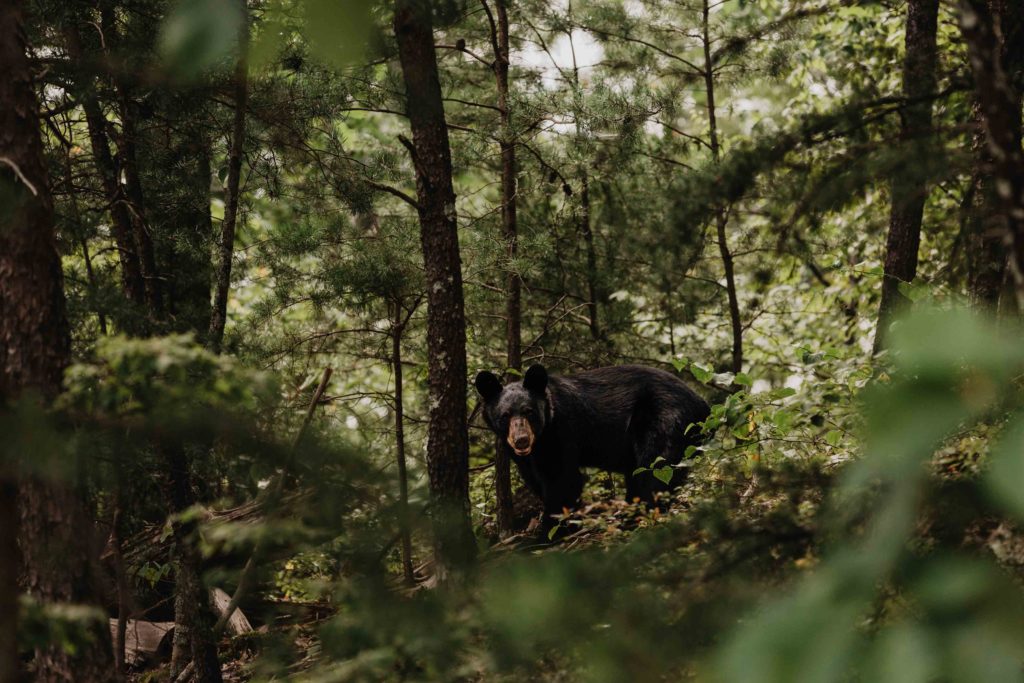
Bear Spray
When it comes to bears, bear spray is a must in some areas, while it’s prohibited in others. Be sure to research the regulations for your specific destination ahead of time to understand what’s allowed. If you’re flying to your elopement location, bear spray can’t be packed in either your carry-on or checked luggage. However, many local recreation shops offer rentals, or you can purchase it online and have it shipped directly to your lodging.
Food and Wildlife
Food and food smells can significantly impact wildlife. Some animals are notorious for being sneaky and will try to steal your food, so always make sure your food (and any scented items) is securely stored if you step away from your pack. This helps prevent unintentionally feeding wildlife, which can lead to animals becoming aggressive and needing to be relocated or euthanized. For backpacking elopements, especially in bear country, it’s essential to use proper food storage. Consider a combo pack with a bear-resistant hanging container and odor-proof bags. Some areas require bear canisters, and you should never bring food into your tent! Bear canisters are often available for rent at National Parks or nearby outdoor stores. Be sure to pack out all your food when you leave.



Pets
Wildlife can be greatly impacted by the presence of our furry companions, so make sure to only bring dogs to areas where they are allowed, and always keep them on a leash and under control. Most National Parks do not permit pets on trails, even if they are on a leash, and some parks have complete pet bans. If bringing your dog is important, many National Forests do allow dogs on a 6-foot leash. Always check specific park rules before heading out to ensure you’re following the guidelines.
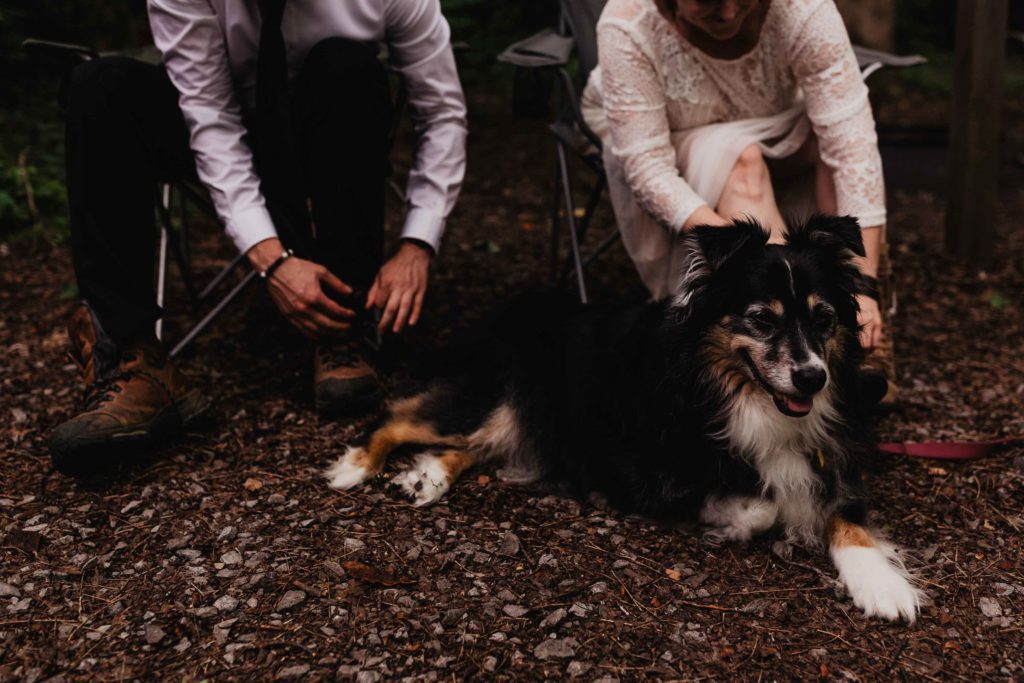
Be Considerate Of Others, Especially If They Are Eloping Too
Eloping continues to grow in popularity each year. While we always aim to find stunning locations that offer privacy, some areas are extremely popular, and we may end up sharing the space with other hikers. Occasionally, we even cross paths with other couples on their own elopement journey! Fortunately, most people are kind and considerate, allowing everyone to enjoy the space and get their photos. Regardless of who we meet along the way, we’ll make sure to share the views and respect their experience as well.



To give you a clear picture of how this works in practice, here’s a brief play-by-play recap of each Leave No Trace principle and how it applies during your elopement day!
- Travel and Camp on Durable Surfaces. Stick to trails and durable surfaces like rock, sand, gravel, ice, snow, and study vegetation like dry grasses for your ceremony, portraits, and activities.
- Dispose of Waste Properly. Before you leave your ceremony or celebration area, be sure to do a good sweep and pick up any little trash items that might have fallen. Use a trash bag to collect any waste that is generated and know the environmental regulations on going to the bathroom in the wilderness.
- Leave What You Find. Everything you see makes up this beautiful landscape—leave all of those treasures where they are! If there is something you see that you love, let your photographer know and they can take a beautiful detailed photo of it instead. “Take nothing but pictures and leave nothing but footprints.”
- Minimize Campfire Impacts. Follow fire regulations and if you do have a campfire, make sure to use an established fire pit, and put it out entirely before leaving. Avoid using sparklers, smoke bombs, or candles in any place that you would not consider safe for a campfire.
- Respect Wildlife. Keep a safe distance from all wildlife you encounter and do not leave your food unattended.
- Be Courteous of Other Visitors. Smile and be friendly to other hikers and even couples/photographers you meet on the trail. Share the views and best photo spots and enjoy being in the beautiful great outdoors together.

